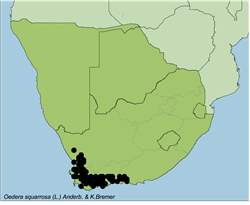Names and synonyms
Oedera squarrosa (l.) Anderberg & Bremer=Relhania squarrosa (L.) L'Heritier =Santolina squarrosa Linnaeus =Athanasia squarrosa (L.) Linnaeus =Eclopes buxifolia Gaertner =Relhania recurva Lessing =Relhania squarrosa (L.) L'Herit. var. �. brevifolia Harvey =Relhania latifolia Compton
Type
Compton, R.H. 15016, Clanwilliam Dist., Het Kruis, 1943-09-29 (NBG, BOL, PRE)
Common names
Vierkantperdekaroo, Krulblaarkoorsbos
Derivation of names
Oedera = after George Christian Oeder (1728-1791), professor of Botany in Copenhagen, author of Flora Danica squarrosus = scruffy, scabby - rough with scale-like projections, spreading in all directions, protruding
Diagnostic characters
Leaves generally 4-ranked and curled backwards, but this can be somewhat variableLeaf margins thickenedLeaves and stems gland-dottedInner involucral bracts also glandular Lamina of ray floret short, shorter than half the length of the involucreCapitula clustered terminally, but some of the lower capitula axillary; up to 22 capitula per inflorescenceInvolucral bracts often with a dark central area
Description
A moderately branched, 0.4-0.6(-0.9) m high shrub. Stems ascending-erect, leafy, becoming nude and marked with leaf-scars. Leaves alternate or decussate and 4-ranked, spreading or usually squarrose-recurved, 2-15 x 1.5-7 mm, glabrous or seldom sparsely pilose marginally, indistinctly glandular-punctate, acute and mucronate with a hooked apex; margins entire, thickened. Capitula 3-12 together in terminal cymes, radiate, yellow, flowerheads 6-8(-10) mm diameter. Peduncles 2-10 mm long during flowering, usually obscured by leaves. Involucre bell-shaped, 2-6(-9) mm wide. Involucral bracts 25-60, outer ovate, inner gradually narrower and longer, innermost with a spreading apical limb, up to 8 mm long, gland-dotted, light yellowish brown with a central greenish patch. Receptacle paleate. Paleae canaliculate, linear or narrowly spatulate, 5-8 mm long, gland-dotted, acute. Ray florets 7-20, tube 2-3 mm long, � glandular; lamina elliptic, 2-3.5 x 0.8-1.5 mm, 4-veined. Disc florets 20-60, perfect. Corolla 3.6-5.6 mm long, 0.6-0.9 mm wide. Cypselas almost terete, linear, 1.8-4.5 x 0.3-0.6 mm, glabrous or sparsely pilose in ray florets. Pappus crownlike, of connate scales, up to 0.6 mm long.
Flowering time
Mainly from August to September (to December).
Distribution
Widespread species of the southern and southwestern Cape (Knersvlakte and Namaqualand) and Eastern Cape. It is not a stricktly montane species but follows the mountain ranges from southern Namaqualand to Eastern Cape. Known from about 200 specimens.
Habitat
Abundant in stony, sandy, loamy and clayey soils in most lowland habitat and flats but also on lower mountain slopes.
Notes
This species is generally not misidentified, but is closely allied to O. genistifolia. Specimens of O. squarrosa are usually distinguished by the typically squarrose-recurved, elliptic, larger leaves, the bell-shaped and wider involucres, and decussate leaf-arrangement in young vegetative shoots.
References
ANDERBERG, A.A. & BREMER, K. 1991. Parsimony analysis and cladistic reclassification of the Relhania generic group (Asteraceae - Gnaphalieae). Annals of the Missouri Botanical Garden 78: 1061-1072.BREMER, K. 1976. The genus Relhania (Compositae). Opera Botanica 40.GOLDBLATT, P. & MANNING, J.C. 2000. Cape Plants. A conspectus of the Cape flora of South Africa. Strelitzia 9. SANBI.HARVEY. 1865. Compositae in: W.H. Harvey & O.W. Sonder. Flora Capensis 3 (ed. 1). Hodges & Smith, Dublin.KESTING, D. & CLARKE, H. 2008. Botanical names, what they mean. Wild Flowers of the Cape Peninsula, 3rd revised edition. Friends of Silvermine.LE ROUX, A. 2005. Namaqualand, South African Wild Flower Guide 1. Botanical Society of South Africa.PHILLIPS.1940. The Flowering Plants of South Africa 20: t. 786SMITH, C. A. 1927. Four interesting species of Compositae. Bothalia 2: 360-365.MANNING. J. 2007. Field Guide to Fynbos. Struik Publishers.VLOK, J. & SCHUTTE-VLOK, A L. 2010. Plants of the Klein Karoo. Umdaus Press

_sml.jpg)